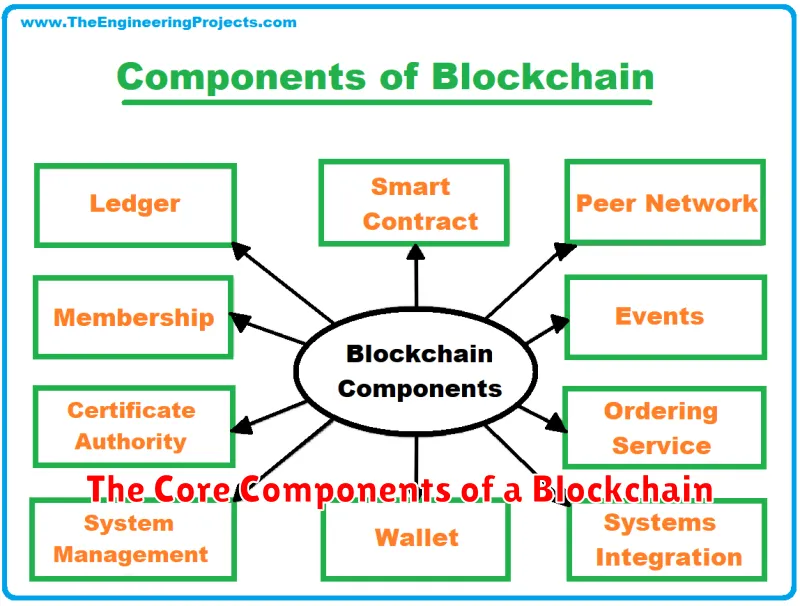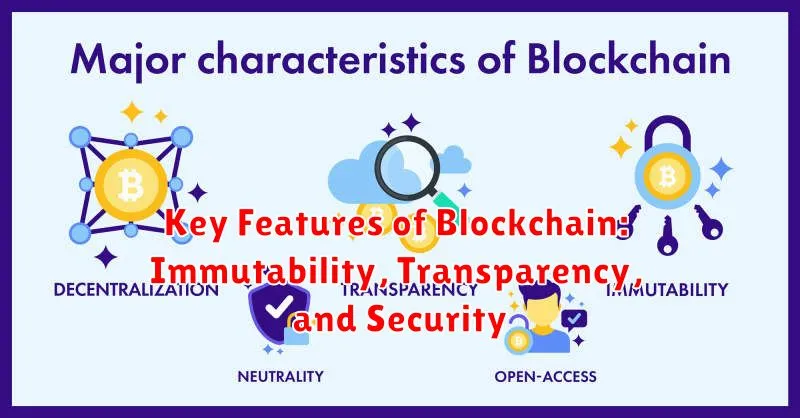Welcome to the world of blockchain, a technology that’s revolutionizing industries and changing the way we think about data, security, and trust. You may have heard whispers of its transformative power, but what exactly is blockchain and how does it work? This comprehensive guide will demystify the technology, explaining its core concepts, exploring its various applications, and providing insights into its potential impact on your life.
From the rise of cryptocurrencies like Bitcoin to the development of innovative solutions in healthcare, supply chain management, and beyond, blockchain is rapidly gaining traction. This guide is your key to understanding the fundamentals, exploring real-world use cases, and discovering how this groundbreaking technology is shaping the future. So, buckle up and prepare to embark on an exciting journey into the world of blockchain.
What is Blockchain Technology?
In the ever-evolving digital landscape, blockchain technology has emerged as a revolutionary force, transforming various industries and reshaping our understanding of data management and security. At its core, a blockchain is a distributed, immutable ledger that records transactions in a secure and transparent manner. Its decentralized nature eliminates the need for a central authority, empowering users with greater control over their data and assets.
Imagine a digital record of transactions that is not stored in a single location but is replicated across a network of computers. This distributed ledger ensures the integrity and immutability of the data, as any attempt to alter it would require hacking into multiple computers simultaneously, making it extremely difficult and virtually impossible.
Key Features of Blockchain Technology:
- Decentralization: Blockchain operates on a peer-to-peer network, eliminating the need for a central authority. This empowers users with greater control over their data and transactions.
- Immutability: Once a transaction is recorded on the blockchain, it is permanent and cannot be altered or deleted. This ensures the integrity and trustworthiness of the data.
- Transparency: All transactions on a blockchain are publicly viewable, promoting accountability and transparency in the system. However, user identities can remain anonymous, depending on the specific blockchain implementation.
- Security: Blockchain leverages advanced cryptography to secure transactions and prevent tampering. The distributed nature of the network further enhances security by making it virtually impossible to hack into the entire system.
How Blockchain Works:
Blockchain technology operates in a series of blocks, each containing a set of transactions. Each block is linked to the previous block, creating a chronological chain of transactions.
When a new transaction occurs, it is broadcasted to the network of computers. These computers, known as nodes, validate the transaction using complex algorithms. Once validated, the transaction is added to a block.
Once a block is filled with transactions, it is added to the blockchain and linked to the previous block. The process of adding a new block is known as “mining,” where miners compete to solve complex mathematical problems to validate the block.
Applications of Blockchain Technology:
Blockchain technology has numerous applications across various industries, including:
- Cryptocurrencies: Bitcoin and Ethereum are the most popular examples of cryptocurrencies powered by blockchain technology.
- Supply Chain Management: Blockchain can track goods throughout the supply chain, ensuring transparency and preventing counterfeiting.
- Healthcare: Securely storing and sharing patient medical records using blockchain can enhance privacy and improve data management.
- Voting Systems: Blockchain can create secure and transparent voting systems, reducing the risk of fraud and increasing voter confidence.
- Digital Identity: Blockchain can be used to create verifiable digital identities, streamlining identity verification processes and reducing fraud.
Challenges and Future of Blockchain:
Despite its potential, blockchain technology faces challenges such as:
- Scalability: Scaling blockchain networks to handle a large volume of transactions can be challenging.
- Regulation: The regulatory landscape for blockchain technology is still evolving, creating uncertainty and potential legal complexities.
- Energy Consumption: Some blockchain implementations, such as proof-of-work consensus mechanisms, can consume significant amounts of energy.
Despite these challenges, blockchain technology is rapidly evolving and gaining momentum. Its potential to revolutionize various industries is undeniable, promising a future where data is more secure, transparent, and accessible.
The Core Components of a Blockchain

A blockchain is a distributed, immutable, and transparent ledger that records and verifies transactions in a secure and verifiable manner. It is a revolutionary technology that has the potential to transform various industries. At its core, a blockchain consists of several key components that work together to ensure its functionality and security.
1. Blocks
The fundamental building block of a blockchain is a block. Each block contains a collection of transactions, a timestamp, a hash of the previous block, and other relevant data. This interconnected chain of blocks forms the blockchain, creating a chronological record of all transactions.
2. Transactions
Transactions are the core operations that occur on a blockchain. They represent the exchange of value or information between two parties. Each transaction is cryptographically signed by the sender, ensuring its authenticity and preventing alteration. Transactions are bundled together into blocks and added to the blockchain.
3. Hashing
Hashing is a crucial element in securing a blockchain. It involves using a mathematical function to generate a unique fingerprint for each block. The hash of a block is dependent on the contents of the previous block, creating an interconnected chain. Any change in a block’s content would result in a different hash, alerting the network to potential tampering.
4. Consensus Mechanism
A consensus mechanism is a process that ensures agreement among all participants in the blockchain network on the validity of transactions and the order in which they are added to the blockchain. Popular consensus mechanisms include Proof of Work (PoW) and Proof of Stake (PoS). These mechanisms maintain the integrity of the blockchain and prevent manipulation or fraud.
5. Cryptography
Cryptography plays a vital role in securing blockchain transactions and ensuring their immutability. It uses mathematical algorithms to encrypt data and protect it from unauthorized access. Cryptographic techniques like digital signatures and asymmetric encryption are employed to authenticate transactions and verify identities.
6. Nodes
Nodes are the individual computers or devices that participate in a blockchain network. Each node maintains a copy of the blockchain and validates transactions. Nodes communicate with each other, ensuring the accuracy and consistency of the shared ledger. The decentralized nature of blockchain relies on the collective efforts of these nodes.
7. Smart Contracts
Smart contracts are self-executing agreements stored on the blockchain. They automate the execution of contracts according to predefined rules, eliminating the need for intermediaries. Smart contracts enhance efficiency, transparency, and security in various applications, including supply chain management and decentralized finance.
Together, these core components contribute to the fundamental principles of blockchain technology: decentralization, immutability, transparency, and security. These attributes make blockchain a powerful tool for a wide range of applications, from financial services to healthcare and beyond.
Key Features of Blockchain: Immutability, Transparency, and Security

Blockchain technology has emerged as a revolutionary force, transforming various industries with its unique capabilities. At its core, a blockchain is a distributed ledger that records transactions in a secure and transparent manner. This technology is built upon several fundamental features that contribute to its robustness and widespread adoption.
Immutability
One of the most defining characteristics of blockchain is its immutability. Once a transaction is recorded on the blockchain, it cannot be altered or deleted. This is because each block in the chain is cryptographically linked to the previous block, creating an unbreakable chain of data. This immutability ensures that records are tamper-proof, fostering trust and accountability.
Transparency
Blockchain is inherently transparent, allowing anyone with access to the network to view the history of transactions. This transparency promotes trust and accountability, as all actions are visible and verifiable. While specific transaction details may be encrypted, the overall flow of data is accessible to all participants.
Security
Security is paramount in blockchain technology. The decentralized nature of the network makes it difficult for malicious actors to compromise the system. Furthermore, blockchain utilizes advanced cryptographic techniques, such as hashing and digital signatures, to secure data and prevent unauthorized access.
Other Key Features
In addition to immutability, transparency, and security, blockchain offers several other notable features, including:
- Decentralization: Blockchain operates on a peer-to-peer network, eliminating the need for a central authority.
- Efficiency: Transactions can be processed quickly and efficiently without relying on intermediaries.
- Cost-effectiveness: Blockchain can reduce transaction fees compared to traditional systems.
Conclusion
Blockchain’s unique features, including immutability, transparency, and security, make it a game-changer across various sectors. Its ability to enhance trust, accountability, and efficiency has led to its widespread adoption in finance, healthcare, supply chain management, and beyond.
How Blockchain Works: A Step-by-Step Explanation

Blockchain is a revolutionary technology that has the potential to change the way we interact with the world. It’s a distributed, decentralized, and secure ledger that records transactions in a transparent and immutable way. But how does it actually work? Let’s break it down step by step.
Imagine a digital ledger that’s shared and synchronized across a network of computers. This is the essence of a blockchain. Every transaction that occurs is recorded as a block, which is then added to the chain in chronological order.
Each block contains a timestamp, transaction data, and a hash of the previous block. This hash, known as a cryptographic fingerprint, acts as a unique identifier and ensures the integrity of the chain. If someone attempts to alter a previous block, the hash will change, alerting everyone on the network to the tampering attempt.
Key Concepts of Blockchain
Understanding these concepts is crucial to grasping how blockchain works:
- Decentralization: Unlike traditional systems that rely on central authorities, blockchain operates on a peer-to-peer network. This eliminates single points of failure and reduces the risk of manipulation.
- Immutability: Once a block is added to the chain, it cannot be altered or deleted. This provides an auditable and tamper-proof record of transactions.
- Transparency: All transactions on the blockchain are publicly viewable, fostering trust and accountability.
- Cryptographic Security: Blockchain utilizes sophisticated cryptographic techniques to secure transactions and protect data.
How Transactions Occur on a Blockchain
1. Transaction Initiation: When a transaction occurs, it’s broadcast to the network.
2. Verification and Validation: Network participants called “nodes” verify the transaction’s validity and ensure that the sender has sufficient funds.
3. Block Creation: Valid transactions are grouped together into a block. This block contains the transaction details, a timestamp, and a hash of the previous block.
4. Block Addition: The new block is added to the chain after a consensus mechanism is achieved. This typically involves miners (in proof-of-work blockchains) or validators (in proof-of-stake blockchains) competing to add the block to the chain.
5. Chain Extension: The process repeats for subsequent transactions, ensuring a continuous and tamper-proof record.
Examples of Blockchain Applications
Blockchain technology is rapidly gaining traction in various industries, including:
- Cryptocurrencies: Bitcoin and Ethereum are the most well-known examples of cryptocurrencies that leverage blockchain technology.
- Supply Chain Management: Tracking goods from origin to destination, ensuring transparency and accountability.
- Healthcare: Securely storing and sharing patient medical records, improving efficiency and data integrity.
- Voting: Ensuring secure and transparent elections by recording votes on a blockchain.
- Digital Identity: Creating verifiable and secure digital identities for individuals and organizations.
The Future of Blockchain
Blockchain technology is still in its early stages, but its potential is immense. As the technology continues to evolve, we can expect to see even more innovative applications and transformative impacts across various sectors.
Types of Blockchain Networks: Public, Private, and Consortium
Blockchain technology has become increasingly popular in recent years, with its potential applications spanning across various industries. However, not all blockchains are created equal. There are different types of blockchain networks, each with its unique characteristics and use cases. This article will delve into the three main types: public, private, and consortium blockchains.
Public Blockchains
Public blockchains are the most decentralized type of blockchain network. They are open to anyone, allowing anyone to join the network, participate in consensus, and validate transactions. Examples of public blockchains include Bitcoin and Ethereum.
Key Features of Public Blockchains:
- Decentralization: No single entity controls the network.
- Transparency: All transactions are publicly viewable on the blockchain.
- Permissionless: Anyone can join the network and participate.
- Immutability: Transactions are permanent and cannot be altered.
Use Cases of Public Blockchains:
- Cryptocurrencies: Bitcoin and Ethereum are prime examples.
- Decentralized applications (DApps): Public blockchains enable the development of decentralized applications.
- Supply chain management: Tracking goods and products across the supply chain.
Private Blockchains
Private blockchains are permissioned networks that are controlled by a single organization. They are typically used for internal purposes within a company or organization. Examples of private blockchains include Hyperledger Fabric and R3 Corda.
Key Features of Private Blockchains:
- Centralized control: A single entity controls the network.
- Permissioned access: Only authorized users can join the network.
- Customization: Private blockchains can be tailored to specific needs.
- Privacy: Transactions are not publicly visible.
Use Cases of Private Blockchains:
- Supply chain management: Tracking goods and products within a company’s supply chain.
- Financial services: Processing transactions and managing assets.
- Healthcare: Storing and sharing patient data securely.
Consortium Blockchains
Consortium blockchains are a hybrid model that combines elements of both public and private blockchains. They are governed by a group of organizations, typically within a specific industry or sector. Examples of consortium blockchains include Hyperledger Besu and R3 Corda Enterprise.
Key Features of Consortium Blockchains:
- Shared control: A group of organizations controls the network.
- Permissioned access: Only authorized members can join the network.
- Collaboration: Enables collaboration between participating organizations.
- Scalability: Can handle larger transaction volumes compared to public blockchains.
Use Cases of Consortium Blockchains:
- Industry-specific applications: Supply chain management, healthcare, financial services.
- Inter-organizational data sharing: Facilitating secure data sharing between organizations.
- Cross-border transactions: Simplifying international trade and financial transactions.
Choosing the Right Type of Blockchain Network
The choice of blockchain network depends on the specific needs and requirements of the application. Public blockchains offer decentralization and transparency but may not be suitable for sensitive data or private applications. Private blockchains provide control and customization but lack the transparency and openness of public blockchains. Consortium blockchains strike a balance between the two, offering collaboration and scalability while maintaining some level of control.
Blockchain Use Cases Beyond Cryptocurrency
Blockchain technology has gained significant traction in recent years, primarily due to its association with cryptocurrencies. While cryptocurrencies have undoubtedly captured the imagination of many, the underlying technology of blockchain offers a vast range of applications that extend far beyond the realm of digital currencies.
At its core, blockchain is a distributed ledger that records transactions in a secure and transparent manner. This decentralized nature of blockchain eliminates the need for a central authority, making it a powerful tool for various industries.
Supply Chain Management
Blockchain can revolutionize supply chain management by providing real-time visibility into the movement of goods. By recording every transaction and interaction along the supply chain, blockchain ensures transparency, traceability, and accountability. This can help businesses identify potential bottlenecks, reduce fraud, and improve efficiency.
Healthcare
In the healthcare industry, blockchain can enhance patient privacy, secure medical records, and streamline data sharing. By creating a secure and tamper-proof ledger, blockchain can facilitate the sharing of patient data among authorized healthcare providers while maintaining confidentiality.
Voting
Blockchain can revolutionize the voting process by providing a secure and transparent platform for casting and counting votes. By eliminating the risk of fraud and manipulation, blockchain can enhance voter confidence and ensure fair and accurate election results.
Digital Identity
Blockchain can play a crucial role in establishing secure and verifiable digital identities. By storing personal information on a decentralized ledger, blockchain can provide individuals with control over their data and reduce the risk of identity theft.
Real Estate
Blockchain can streamline real estate transactions by simplifying the process of buying, selling, and managing property. By recording ownership and transactions on a secure ledger, blockchain can eliminate the need for intermediaries and expedite the closing process.
Conclusion
The potential applications of blockchain extend far beyond cryptocurrency. By leveraging its inherent qualities of security, transparency, and decentralization, blockchain can transform various industries and create new opportunities for innovation. As the technology continues to mature, we can expect to see even more transformative use cases emerge.
Blockchain in Supply Chain Management: Enhanced Transparency and Traceability

In the realm of supply chain management, transparency and traceability have emerged as paramount concerns. The traditional, paper-based systems often fall short in providing real-time visibility, leading to inefficiencies, delays, and a lack of accountability. Enter blockchain, a revolutionary technology with the potential to transform supply chain operations by offering unparalleled transparency, security, and immutability.
What is Blockchain?
Blockchain is a distributed, decentralized ledger that records transactions in a secure and tamper-proof manner. Each block in the chain contains a timestamp, transaction data, and a hash of the previous block. This creates a chronological, auditable trail of every transaction, making it virtually impossible to alter or falsify data.
Benefits of Blockchain in Supply Chain Management
The implementation of blockchain in supply chain management offers numerous benefits:
Enhanced Transparency
Blockchain allows all stakeholders, including suppliers, manufacturers, distributors, and retailers, to access real-time data on product provenance, movement, and condition. This transparency fosters trust and collaboration throughout the supply chain.
Improved Traceability
The immutable nature of blockchain enables precise tracking of products from origin to destination. This traceability is crucial for identifying potential issues, recalling faulty products, and ensuring compliance with regulatory standards.
Reduced Costs
By streamlining processes and eliminating intermediaries, blockchain can significantly reduce operational costs. For instance, it eliminates the need for manual data entry, reduces paperwork, and minimizes the risk of fraud.
Increased Efficiency
Blockchain automation enables faster and more efficient processes, such as order fulfillment, inventory management, and payment processing. This results in improved delivery times and reduced lead times.
Enhanced Security
Blockchain’s decentralized nature and cryptographic security measures safeguard data against unauthorized access, tampering, and data breaches.
Real-World Applications of Blockchain in Supply Chain Management
Blockchain is already being implemented by a growing number of companies across various industries. Some examples include:
Food Safety
Blockchain tracks the journey of food products, enabling quick identification of contaminated batches and reducing the risk of foodborne illnesses.
Pharmaceutical Supply Chain
Blockchain ensures the authenticity and integrity of medicines, combating counterfeiting and ensuring the safe delivery of medications.
Luxury Goods
Blockchain helps authenticate luxury goods, preventing counterfeiting and ensuring the sale of genuine products.
Sustainable Sourcing
Blockchain enables transparent tracking of products from sustainable sources, ensuring ethical and responsible practices.
Challenges and Considerations
While blockchain holds immense potential, its implementation in supply chain management also presents certain challenges:
Scalability
Handling large volumes of transactions on the blockchain can pose a scalability challenge. However, ongoing advancements are addressing this issue.
Interoperability
Different blockchain platforms may not be compatible, hindering seamless data exchange across the entire supply chain.
Regulatory Landscape
The regulatory landscape surrounding blockchain is still evolving, requiring clarity and harmonization across jurisdictions.
The Future of Blockchain in Supply Chain Management
As blockchain technology continues to mature and evolve, its role in supply chain management is poised to become increasingly significant. With its ability to enhance transparency, traceability, and efficiency, blockchain promises to reshape the future of supply chain operations, making them more resilient, secure, and sustainable.
Blockchain in Healthcare: Secure Data Sharing and Patient Privacy

The healthcare industry is undergoing a digital transformation, with the adoption of technology like blockchain emerging as a key driver of innovation. Blockchain, a decentralized and secure ledger technology, holds immense promise for revolutionizing healthcare by enhancing data sharing, improving patient privacy, and streamlining processes.
One of the most significant challenges in healthcare today is the siloed nature of patient data. Information is often scattered across various healthcare providers, making it difficult to access and share securely. Blockchain can address this by creating a single, immutable record of patient data that is accessible to authorized parties. This decentralized system eliminates the need for central authorities to control data access, ensuring transparency and accountability.
Furthermore, blockchain technology offers enhanced security measures to protect sensitive patient information. Cryptographic hashing and encryption techniques make it virtually impossible to alter or tamper with data once it is recorded on the blockchain. This immutability ensures the integrity and authenticity of patient records, fostering trust and confidence in the healthcare ecosystem.
In addition to data security, blockchain can also facilitate secure data sharing between different stakeholders. For example, patients can grant authorized healthcare providers access to their medical records through a blockchain-based system. This empowers individuals to control their health data and improve interoperability between healthcare providers.
The potential applications of blockchain in healthcare extend beyond data sharing and privacy. Blockchain can also be used to streamline processes like supply chain management, clinical trial management, and electronic health records (EHR). By simplifying these processes, blockchain can reduce costs, improve efficiency, and ultimately enhance patient care.
However, it’s important to acknowledge the challenges that need to be addressed for wider adoption of blockchain in healthcare. These include regulatory concerns, scalability issues, and the need for greater education and awareness among healthcare professionals. Nevertheless, the potential benefits of blockchain are undeniable, and the technology is poised to play a significant role in shaping the future of healthcare.
Blockchain in Finance: Revolutionizing Transactions and Payments

The financial industry has undergone a dramatic transformation in recent years, with blockchain technology emerging as a game-changer. Blockchain, a decentralized and transparent ledger, is fundamentally altering the way transactions and payments are conducted. Its ability to streamline processes, enhance security, and reduce costs has captivated the attention of financial institutions and businesses alike.
The Power of Decentralization
One of the key advantages of blockchain is its decentralized nature. Unlike traditional systems that rely on central authorities, blockchain transactions are recorded and verified across a distributed network of computers. This eliminates the need for intermediaries, such as banks or payment processors, thereby reducing fees and increasing efficiency.
Uncompromising Security
Blockchain’s robust security features are unparalleled. Each transaction is encrypted and immutably recorded on the blockchain, making it virtually tamper-proof. This inherent security makes it an ideal platform for managing sensitive financial data, mitigating risks associated with fraud and cyberattacks.
Transparency and Traceability
Transparency is another hallmark of blockchain. All transactions are publicly accessible and auditable, providing a clear and transparent record of financial activities. This enhanced transparency fosters trust and accountability within the financial ecosystem.
Smart Contracts: Automating Processes
Blockchain technology facilitates the use of smart contracts, self-executing agreements that automate various financial processes. Smart contracts eliminate the need for intermediaries and ensure that transactions are completed automatically and accurately, reducing errors and delays.
Transforming Payments and Transfers
Blockchain is revolutionizing the way payments and transfers are made. By leveraging blockchain’s speed, security, and low costs, businesses can process transactions more efficiently and cost-effectively. Moreover, blockchain-based payment systems are particularly beneficial for cross-border transactions, simplifying the process and reducing fees.
Emerging Applications in Finance
Blockchain’s applications in finance extend beyond payments and transfers. It is being explored for various purposes, including:
- Securities Trading: Blockchain can streamline and automate securities trading, reducing settlement times and improving transparency.
- Digital Assets: Blockchain underpins the creation and management of digital assets, such as cryptocurrencies and digital tokens.
- Lending and Borrowing: Decentralized finance (DeFi) platforms leverage blockchain to facilitate peer-to-peer lending and borrowing.
- Insurance: Blockchain can enhance transparency and efficiency in insurance claims processing and risk management.
Conclusion
Blockchain technology is poised to transform the financial landscape, offering unprecedented levels of efficiency, security, and transparency. Its adoption across various financial applications is accelerating, paving the way for a more inclusive and innovative financial future.
The Future of Blockchain: Trends and Predictions
Blockchain technology has emerged as a transformative force across various industries, revolutionizing the way we conduct transactions, manage data, and interact with each other. As blockchain continues to evolve and mature, it’s exciting to delve into the future trends and predictions that will shape its trajectory in the coming years.
Increased Adoption and Mainstream Integration
One of the most significant trends we can expect is a surge in blockchain adoption across diverse sectors. From finance and supply chain management to healthcare and government services, blockchain’s capabilities are becoming increasingly recognized and implemented. This widespread adoption will drive innovation and create new opportunities for businesses and individuals alike.
Interoperability and Cross-Chain Solutions
Currently, blockchain networks operate in silos, limiting interoperability and seamless data transfer. The future holds great promise for interoperability solutions that bridge these gaps. Cross-chain protocols will enable communication and asset exchange between different blockchain platforms, fostering a more connected and integrated ecosystem.
Decentralized Finance (DeFi) and Web3
Decentralized finance (DeFi) has gained immense traction, offering alternative financial services built on blockchain technology. The future of DeFi lies in expanding its reach, developing more sophisticated protocols, and integrating with other emerging technologies like Web3. This will empower individuals with greater control over their finances and create a more inclusive and equitable financial system.
Regulation and Governance
As blockchain adoption grows, regulatory frameworks and governance structures will become crucial for ensuring responsible and sustainable growth. Governments and regulatory bodies worldwide are actively exploring ways to regulate blockchain activities, promoting innovation while addressing potential risks. Clear and consistent regulations will foster investor confidence and create a more stable environment for blockchain development.
Sustainability and Environmental Impact
The environmental impact of blockchain technology is a critical concern. Energy-efficient blockchain solutions and proof-of-stake consensus mechanisms are gaining momentum, reducing the energy consumption associated with traditional proof-of-work protocols. These advancements are essential for ensuring the long-term viability and sustainability of blockchain technology.
Emerging Use Cases and Applications
Blockchain technology has the potential to revolutionize countless industries. Smart contracts are transforming agreements and automate processes, while non-fungible tokens (NFTs) are disrupting digital ownership and collectibles. As research and development continue, we can expect to see even more innovative applications emerge, pushing the boundaries of what’s possible with blockchain.
Conclusion
The future of blockchain is brimming with possibilities. With continued innovation, widespread adoption, and responsible development, blockchain technology will continue to transform our world. By embracing these trends and predictions, we can prepare for a future where blockchain plays a central role in shaping our economy, society, and daily lives.
Challenges and Opportunities in Blockchain Adoption
Blockchain technology has emerged as a revolutionary force, promising to transform various industries. Its decentralized nature, transparency, and security features have captured the attention of businesses, governments, and individuals alike. However, the widespread adoption of blockchain faces significant challenges and opportunities that need careful consideration.
Challenges
One of the primary challenges is the scalability of blockchain networks. The limited transaction throughput of many existing blockchains can hinder their ability to handle large-scale adoption. Interoperability between different blockchains is another challenge, as lack of standardized protocols can create fragmentation and hinder seamless data exchange. Moreover, regulatory uncertainty surrounding blockchain technology poses a significant obstacle for businesses, as they navigate unclear legal frameworks and compliance requirements. Security concerns related to smart contracts, consensus mechanisms, and vulnerabilities are also paramount, requiring robust security measures to ensure the integrity and trust of blockchain networks.
Opportunities
Despite these challenges, blockchain adoption presents numerous opportunities. The decentralized nature of blockchain technology can empower individuals and organizations by providing greater control over their data and assets. Transparency and auditability can enhance trust and accountability in various industries, from supply chain management to financial transactions. Smart contracts can automate processes, reduce costs, and streamline workflows, while tokenization can enable the creation of new digital assets and markets. Blockchain technology has the potential to revolutionize healthcare, education, and other sectors, promoting efficiency, innovation, and social impact.
Moving Forward
To overcome challenges and harness opportunities, stakeholders must collaborate to address key issues. Technical advancements are crucial for enhancing scalability, interoperability, and security. Regulatory clarity is essential to provide a stable and predictable environment for businesses to invest in blockchain technology. Education and awareness are vital to foster a better understanding of blockchain’s potential and address concerns. By fostering innovation, collaboration, and responsible development, blockchain technology can realize its full transformative potential.

